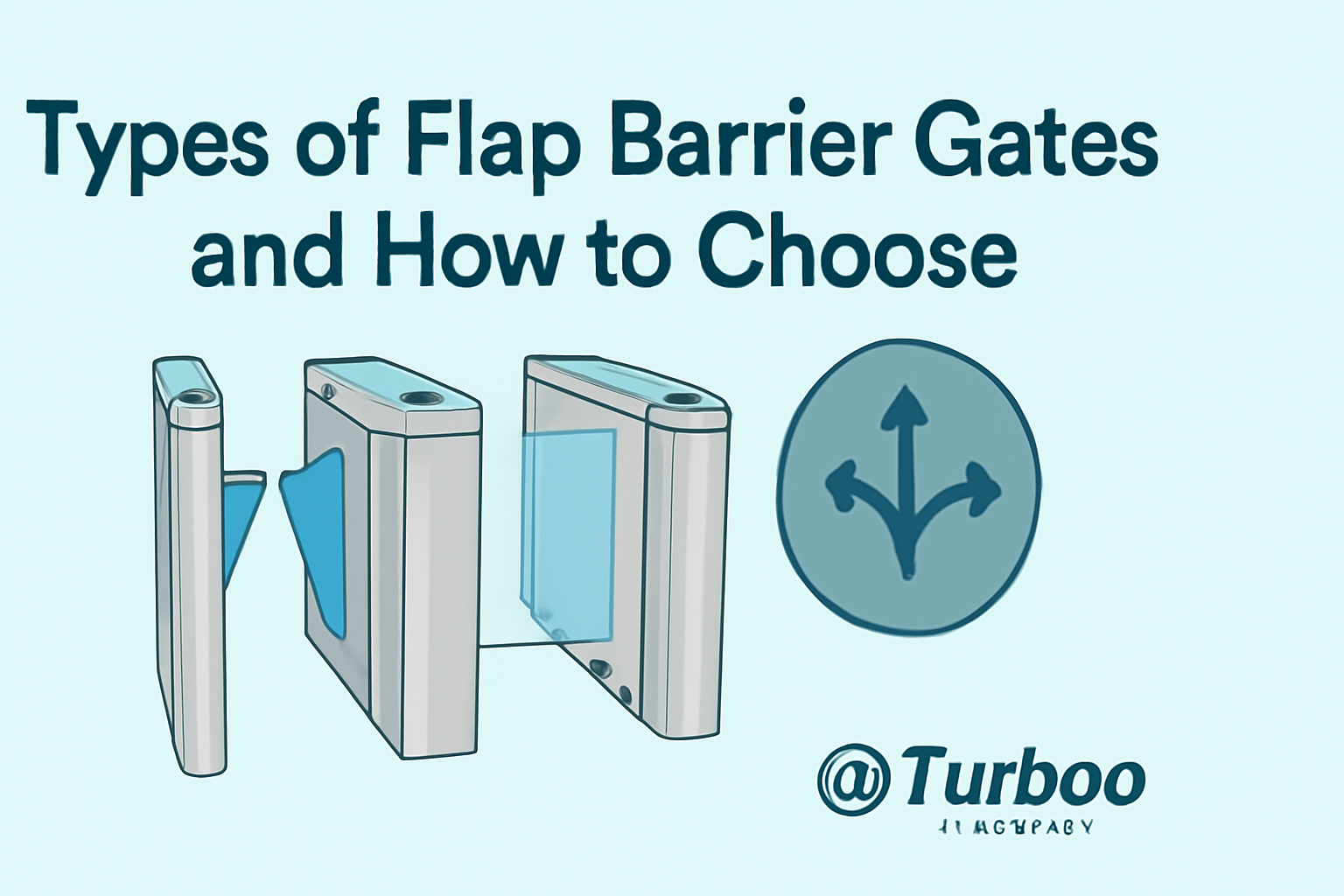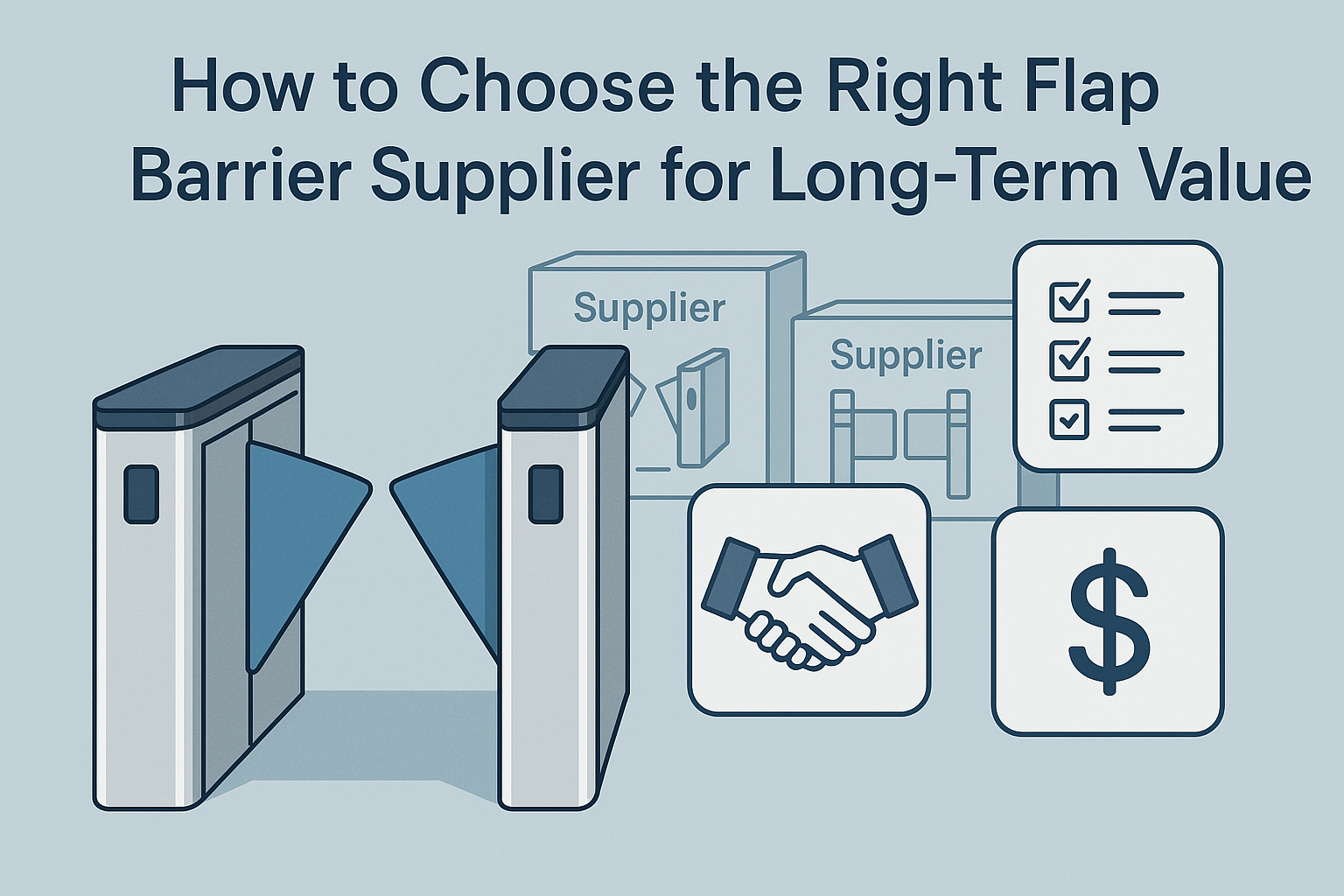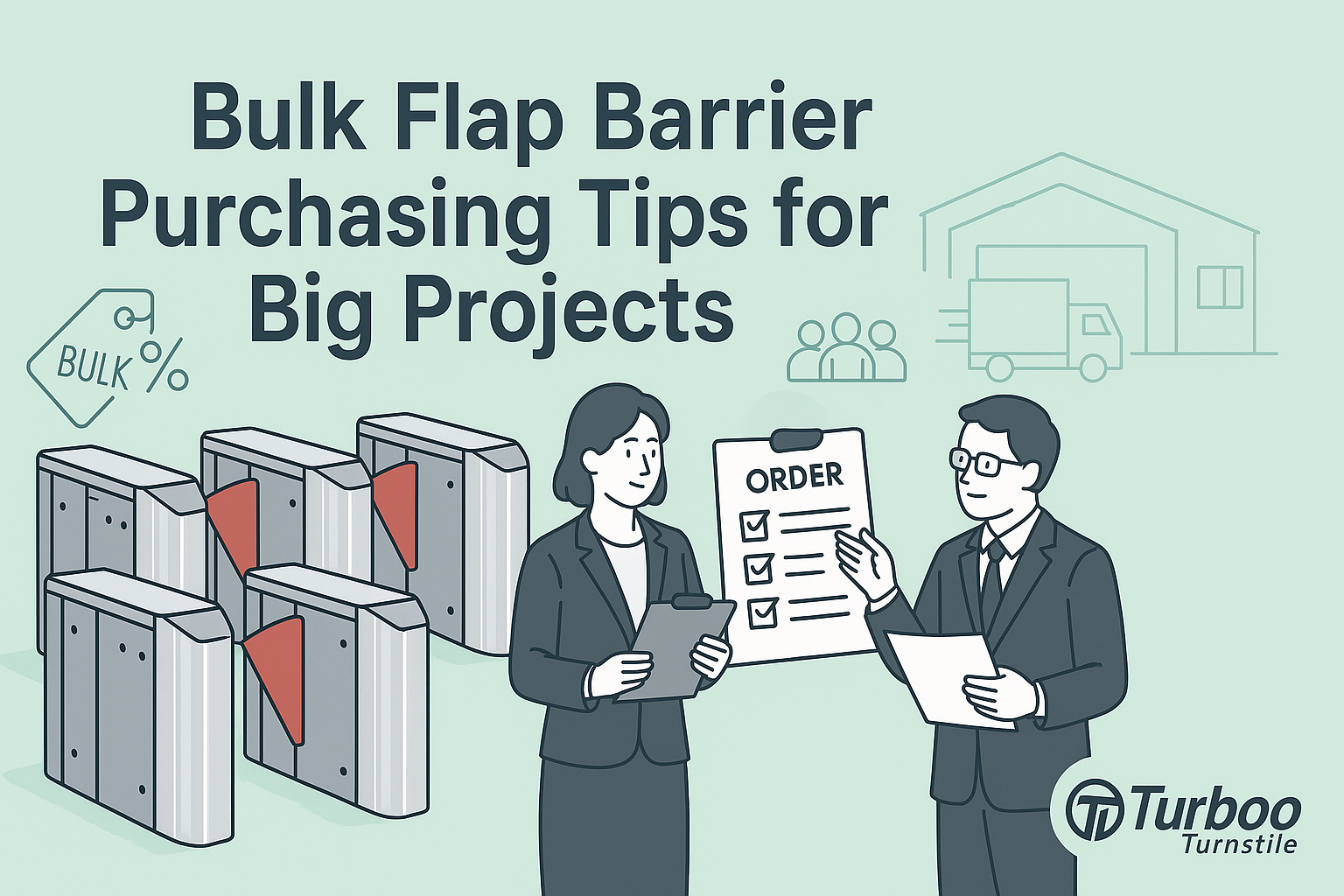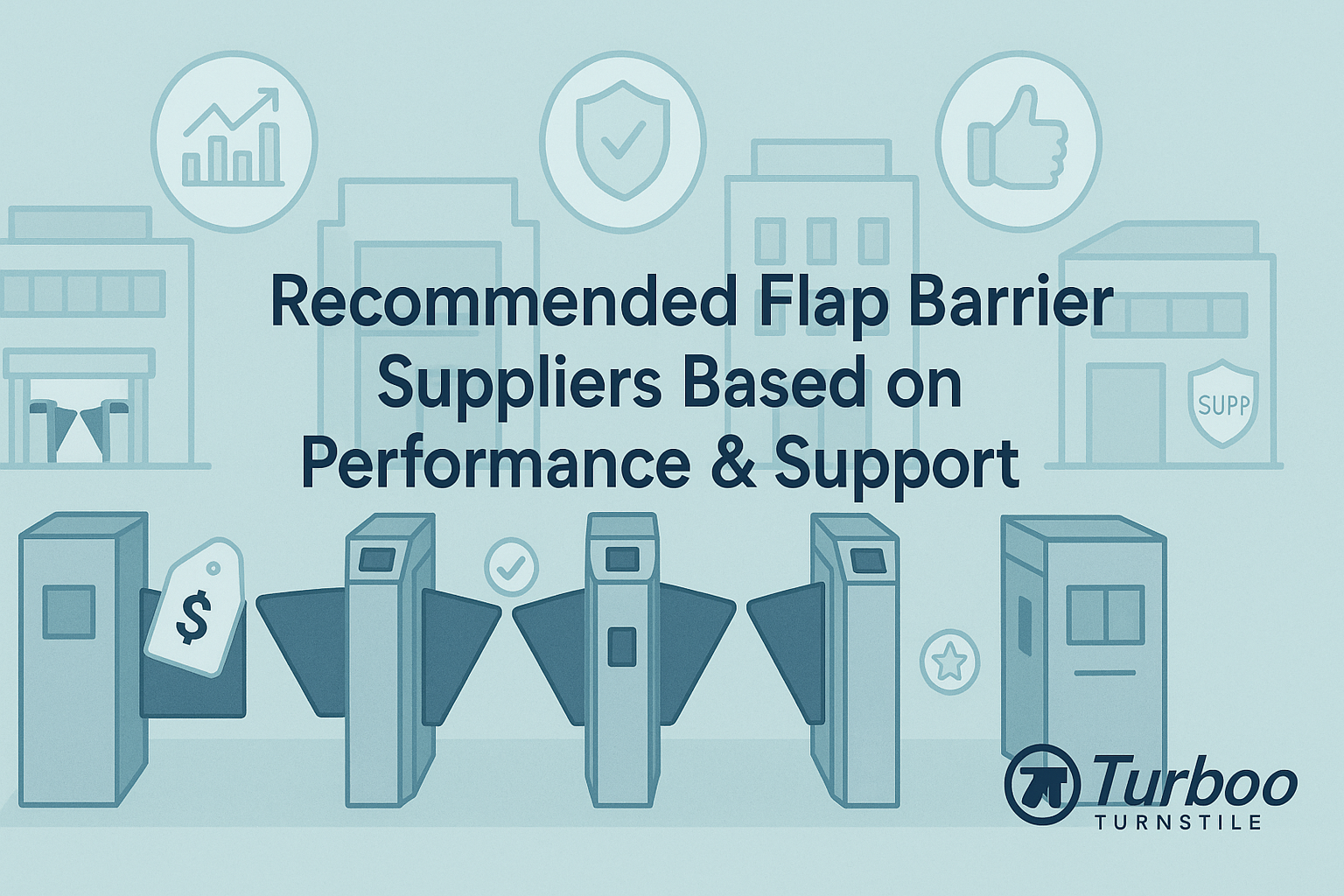Types of Flap Barrier Gates and How to Choose


Flap barrier gates aren’t one-size-fits-all. They come in multiple types, each suited for different facility needs. Choosing the right one impacts not just security but also traffic flow and user satisfaction. A wrong choice can result in delays, frustrated users, or even regulatory non-compliance.
That’s why selecting the right flap barrier gate is critical. This article explores the major gate types and where they work best. You’ll see how wide gates serve accessibility, how standard designs handle daily office use, and how custom gates solve special challenges.
The goal is simple. Make an informed decision that improves safety, reduces bottlenecks, and supports your operational goals. In the next sections, we’ll break down the common gate types, compare their features, and guide you in matching them with your specific facility.
Understanding Flap Barrier Gates
What Are Flap Barrier Gates?
Flap barrier gates are a type of physical access control device. They regulate who can enter or exit a secured area using a moving flap mechanism. These flaps retract into the housing or swing open when access is granted. When unauthorized access is attempted, the flaps remain locked, preventing entry.
These gates use access credentials like cards, mobile apps, biometrics, or PINs. Their purpose is not only to stop unauthorized users but also to track authorized movements and ensure compliance with security protocols.
Flap barrier gates are used across a wide range of facilities—corporate offices, hospitals, stadiums, factories, and schools. Each environment has different needs. That’s why choosing the correct type based on your layout, traffic flow, and access logic is so important.
Why Choosing the Right Type Matters
Gate types influence how smoothly your entry system works. A narrow gate in a high-traffic lobby causes backups. A non-compliant gate in a hospital might exclude patients who use wheelchairs. A standard gate without high-security functions won’t meet the needs of a sensitive lab or data center.
Making the wrong choice isn’t just inconvenient—it can be costly. Retrofitting gates or replacing incompatible models wastes budget and time. By understanding the differences between gate types, you can choose a system that aligns with your security level, facility layout, and user needs from the start.
That’s where this guide comes in. It walks you through the most common gate types and explains where each one fits best.
Standard Flap Barrier Gates
Features and Gate Specifications
Standard flap barrier gates are the most commonly used models. These gates typically feature a slim design with a mid-width passage and fast flap operation. They support basic access control methods like RFID cards and PIN pads, though many models also allow upgrades to biometrics or mobile credentials.
Gate specifications often include 600–650 mm lane width, stainless steel construction, and bi-directional movement. The motors are usually brushless DC types for silent and efficient operation. Most standard gates include LED indicators and infrared sensors for safety and tailgate prevention.
This balance of speed, reliability, and moderate width makes standard flap barriers ideal for regular daily use.
Where Standard Gates Work Best
Standard flap gates work well in commercial buildings, educational institutions, and medium-security environments. They’re ideal for entry points where people flow steadily but not overwhelmingly.
Offices use them in reception areas to monitor staff and visitors. Schools may place them near dormitory entrances or library access zones. Anywhere you need a controlled but smooth entry point, these gates perform well.
Because of their moderate size, they can fit into small lobbies or narrow corridors without major remodeling. This adaptability adds to their popularity.
Pros and Cons of Standard Designs
Standard gates offer affordability and versatility. They’re widely available, easy to install, and compatible with many access control platforms. Their simple configuration also means fewer points of failure and quicker maintenance.
However, they may not support large baggage, strollers, or wheelchairs. Their standard width limits usability for people with mobility needs. They’re also not the best choice for ultra-high security areas where dual authentication or bulletproof materials are required.
Still, for most facilities seeking basic entry control and a solid user experience, standard flap barrier gates are a reliable choice.
Wide Flap Barrier Gates
Benefits of Wide Access
Wide flap barrier gates are designed to accommodate larger entries. They feature expanded lane widths—typically around 900 mm or more. These gates serve users who require additional space due to wheelchairs, carts, luggage, or service equipment.
Their flaps are longer or taller, and they open with a wider angle. Motors are often slightly more powerful to manage the extra movement without slowing down. Sensors are placed strategically to detect larger objects and ensure safety.
The main advantage of wide gates is inclusivity. They ensure compliance with accessibility laws and support all types of users equally.
Ideal Environments for Wide Gates
Wide flap barrier gates are commonly used in hospitals, airports, train stations, and public service buildings. These environments must support a wide range of user needs—from wheelchairs and walkers to rolling luggage and delivery carts.
They’re also useful in schools and universities, where students or staff may transport equipment or personal items on wheeled carts.
Public spaces benefit greatly from wide gates because they reduce exclusion and accommodate diverse user profiles without needing separate entrances.
Accessibility and Compliance Advantages
Many countries require accessible pathways under building codes. Wide gates help meet these accessibility and compliance standards. They ensure all users can move through secure areas with dignity and independence.
These gates often include visual and audio indicators, anti-pinch safety features, and smooth flap movement to support users with limited mobility.
While wide gates take up more space and cost slightly more, the benefits far outweigh the trade-offs in facilities with inclusive access requirements.
Customized Flap Barrier Gates
What Custom Gates Offer
Customized flap barrier gates are designed to meet very specific needs. They allow flexibility in size, materials, access technology, aesthetics, and integration features. These gates are often used in high-profile or high-risk environments where standard options aren’t enough.
Customization includes things like wood-finished panels for luxury hotels, biometric-only access for research labs, or curved gates to match architectural constraints.
Customization isn’t just visual. It extends to internal logic, sensor placement, software compatibility, and safety controls.
Environments That Demand Customization
You’ll find customized gates in corporate headquarters, embassies, government buildings, casinos, and data centers. Any facility that requires enhanced branding, ultra-high security, or architectural integration will benefit.
These gates can also be designed for unique traffic patterns—like one-way-only entries, extra-fast throughput, or time-of-day access modes.
Where off-the-shelf units fall short, custom flap barrier gates offer complete alignment with facility strategy.
Examples of Custom Features
Common features include dual authentication mechanisms, glass panels etched with branding, height extensions to prevent jumping, and special coatings for outdoor use.
Other examples include gates that support AI-based facial recognition, link directly to cloud-based access systems, or include digital display screens for user feedback.
Customization ensures your flap barrier system fits like a glove—both visually and functionally.
Comparing Flap Gate Types
Differences in Design and Functionality
Each type of flap barrier gate brings a different balance of design and functionality. Standard gates are sleek, compact, and easy to integrate into smaller lobbies or moderate traffic points. They focus on simplicity and serve general access needs well.
Wide gates, by contrast, are larger and engineered for accessibility. Their design allows more physical space and includes more robust sensors to detect a broader range of movement and objects. Functionally, they offer everything a standard gate does, but with additional safety and compliance elements.
Customized gates offer the most flexibility. They are not confined by typical design molds. These gates vary in height, width, shape, and finish. They can integrate any access system, support complex logic, and match unique architectural styles.
Design choices influence not only appearance but also how well the gate performs in your specific environment.
Access Options Across Gate Types
All gate types—standard, wide, or custom—can be equipped with a variety of access options. Card readers, fingerprint sensors, facial recognition devices, mobile scanners, or PIN pads can be added based on your preferred credential method.
Standard gates usually support one or two access modes. Wide gates may need modified panel placement to accommodate equipment like facial scanners at user-friendly heights. Custom gates allow total freedom—multi-modal access, large display screens, or integrations with biometric time attendance systems.
Functionally, all gate types can be upgraded to meet your access control system’s needs. It’s the physical form factor that may limit placement, installation time, or modification ease.
Performance Under Different Traffic Levels
The type of flap barrier gate you choose significantly affects performance under peak load. Standard gates are suitable for moderate flows—offices, internal building zones, or small lobbies.
Wide gates operate slightly slower due to the broader motion, but are necessary for locations with mixed user groups. They perform best when spaced out or supplemented with multiple lanes.
Custom gates can be designed for high-throughput environments like train stations or stadium entrances. They can be built to operate faster, scan in batches, or even allow one-time mass access passes via QR scanning or facial group recognition.
Throughput rates vary, so selecting a gate type that matches your traffic pattern ensures smoother operations and fewer delays.
Barrier Specifications That Impact Gate Choice
Size, Materials, and Motor Types
Flap barrier gates differ in width, height, and housing depth. Standard gates fit into tighter spaces, while wide gates need room to operate safely. Customized models are built around your environment, which may include curved surfaces, uneven floors, or unusual entry angles.
Material choice matters too. Stainless steel is common for durability, while glass or aluminum may be used in premium spaces. Corrosion-resistant finishes are vital in coastal or outdoor areas.
Motor type affects speed, noise, and longevity. Most quality gates use brushless DC motors for smooth and quiet operation. Some models may include stepper motors for higher torque or AC motors in older designs.
Each element—size, finish, mechanism—contributes to how well your gate performs long-term. That’s why it’s critical to understand all barrier specifications before making a selection.
Speed and Safety Sensors
Gate opening and closing speeds influence user satisfaction. A slow gate in a busy office causes congestion. A gate that closes too quickly may pose a hazard. Most standard gates open in 0.6–1.0 seconds, while wide gates may take up to 1.5 seconds.
Safety sensors are standard now but vary in number and function. Infrared beams detect motion and prevent flaps from closing if a user is still inside the lane. Advanced systems use multi-point beams to detect children, luggage, or service animals.
Emergency features like auto-open on power failure, integration with fire alarms, and visual/audio alerts also differ by gate type and manufacturer.
Ensure that the gate you choose includes the right mix of speed and safety features for your user base.
Barrier Specifications to Know Before Buying
Before buying any flap barrier gate, you should know its passage width, power consumption, material composition, IP rating (for dust and water resistance), and supported access systems.
Also consider ambient operating temperature, motor life cycle rating, and compatibility with your access control panel or management software.
Technical specs define what’s possible. Matching specs to your actual needs prevents mismatch errors, delays, or expensive retrofits.
Access Control Gate Options
Access Options Overview
Flap barrier gates are as effective as the systems that control them. Access control options determine how users pass through. Cards, fingerprints, mobile credentials, QR codes, or facial recognition devices can be used with any gate type—provided the mounting and software support are there.
Each option has trade-offs. Cards are affordable but can be lost. Mobile apps are convenient but rely on device compatibility. Biometrics are secure but need more processing power and user training.
When evaluating gate types, always consider which access methods you need now—and in the future.
Matching Gate Types to Security Features
Basic entry points need basic access. A standard gate with RFID support might suffice. But if you’re protecting a secure zone like a research lab, you may need a wide or custom gate that supports two-factor authentication.
Security gates should integrate with surveillance cameras, alert systems, and logging tools. Some gate types offer more space or interfaces for these integrations than others.
Matching security features to gate design ensures that access control isn’t just functional—it’s strategic.
Selecting Based on Credential Method
Not every access method works equally well with every gate design. A facial recognition panel requires proper height and lighting. Mobile QR scanning needs clear sight lines and fast processing.
Gate type affects credential efficiency. Wider gates need differently placed panels. Custom gates can embed readers at custom heights or angles. Standard gates may limit space for multi-reader setups.
Plan your access method first. Then select a gate that best supports it—physically and logically.
Space and Layout Considerations
Gate Width and Installation Area
Your space determines what gate types will physically fit. Standard gates need less than a meter of width per lane. Wide gates may need 1.2 meters or more. Customized gates can be adapted to fit unconventional areas, but need early planning.
The installation zone must also account for flap movement space, control panel mounting, user standing areas, and entry approach direction.
Measure your space with real-world movement in mind. Avoid placing gates too close to walls, corners, or furniture that may obstruct flow or cause accidents.
Managing Entry and Exit Paths
Facilities should consider how users approach the gate. Are they coming in large groups or individually? Are they pushing luggage, using wheelchairs, or carrying tools? These factors affect where and how gates should be placed.
In high-traffic zones, dual-lane setups with clear entry and exit paths reduce congestion. Emergency exits should never rely solely on barrier-controlled access.
Entry and exit paths should be intuitive, well-lit, and marked with clear signs. The gate type must support this layout to avoid confusion and misuse.
Adapting Gate Types to Spatial Constraints
If space is limited, modular or slim-profile standard gates are often best. For more open lobbies or public access zones, wide or custom gates can improve inclusivity and navigation.
Some gates come with foldable flaps or dual-direction settings to save space. Others allow remote control or time-based scheduling to open during peak hours only.
Custom gates can include corner-compatible layouts or L-shaped housing for compact environments. Space constraints don’t mean you have to compromise on access control—just plan with the right gate type in mind.
Budget and Operational Planning
Budget and operational planning are critical when choosing flap barrier gates. Each gate type carries different upfront costs. Standard gates tend to be the most affordable. Wide gates cost more because their motors and sensors are larger. Customized gates command a premium for design, materials, and integration work.
Beyond purchase price, plan for installation expenses. Electrical work, network cabling, and construction modifications add to the budget. Maintenance must also be forecast. Motor replacements, sensor recalibration, and routine cleaning impact operational costs.
Consider total cost of ownership. A slightly more expensive gate may require less service and last longer. Energy consumption matters too. Efficient brushless DC motors save power over time. Factoring all these elements ensures your flap barrier gates meet both budget and performance goals.
User Volume and Throughput Needs
Traffic volume drives gate selection. High-traffic facilities need rapid throughput. Standard gates can handle moderate flows but may clog under peak loads. Wide gates allow larger objects but open more slowly. Customized gates can be optimized for speed with stronger motors and streamlined flaps.
Estimate peak entry rates. Subways and stadiums may require dozens of lane entries per minute. Office lobbies see far fewer. Matching gate speed to user volume avoids delays and frustration.
Throughput also ties into safety. Sensors must reset quickly between cycles. Poorly tuned gates risk trapping or tailgating. Ensuring that your selected gate type supports desired cycle rates is essential for smooth operations.
Security Level Requirements
Not all flap barrier gates offer the same security. Basic models enforce single-user access with simple credential checks. Advanced gates prevent tailgating, piggybacking, and forced entry. Some incorporate anti-tailgate algorithms that trigger alarms or lock down lanes on suspicious reuse of credentials.
High-security zones demand multi-factor authentication. Customized gates can integrate biometrics, two-step card-and-PIN systems, or even visitor pre-registration portals. Integration with building management or surveillance platforms further elevates security posture.
Define your risk tolerance early. A warehouse may prioritize speed over intrusion detection. A data center demands rigorous access logs and physical deterrents. Choosing a gate type aligned with your security level prevents retrofits and enhances protection.
Compliance and Accessibility Standards
Compliance with accessibility and safety standards is non-negotiable. Wide gates help meet ADA requirements by accommodating wheelchairs and mobility aids. Standard gates may leave certain users stranded or require a separate, less secure entrance.
Local building codes often dictate emergency egress. Flap barrier gates must unlock automatically in a fire alarm scenario. Some jurisdictions require specific sensor redundancies, such as dual-beam or pressure-sensitive mats, to prevent injury.
Ensure that your chosen gate type and configuration satisfy both accessibility laws and fire safety regulations. Non-compliance risks fines, project delays, and liability. Customized gates can be designed from the ground up to meet any niche compliance need.
Industry-Specific Gate Applications
Different industries have distinct demands for flap barrier gates. Office buildings require a blend of speed and aesthetics. Glass-front standard gates often suffice for corporate lobbies. Hospitals need quiet, wide gates with touchless options to enhance hygiene and patient flow.
Educational campuses gain from modular standard gates at library and dormitory entries. If equipment transport is frequent, wide or custom gates ensure smooth access. Transportation hubs demand gates that can integrate QR and NFC scanning for ticketing. Stadiums and arenas often use custom gates with high-throughput sensors and robust housing to withstand heavy use.
Factories may favor hard-wearing standard or wide gates with simple card or PIN access. Cleanrooms and labs often choose custom gates that link directly to environmental controls. Knowing your industry’s common use cases helps you refine gate type decisions.
Using a Buying Guide
A comprehensive buying guide streamlines your selection. The Buying Guide outlines key factors such as lane width, credential support, and environmental suitability. It compares models side by side and highlights customization paths.
Refer to vendor case studies and spec sheets. Confirm that the guide covers installation timelines, warranty terms, and service plans. Good guides also include checklists for site inspection and technology compatibility.
A buying guide is only as good as its sources. Validate recommendations with pilot testing or vendor demonstrations. This hands-on research helps avoid surprises during full deployment.
Expert Resources on Gate Types
Industry bodies provide valuable insights into gate types and best practices. IFSEC Global’s access control section offers articles and case studies on emerging flap barrier trends and gate types. Their resources detail how new materials and AI sensors affect performance.
The Security Industry Association’s selection guide delves into standards, compliance updates, and vendor comparisons. Their white papers discuss lifecycle costs, interoperability challenges, and security integration strategies.
Consulting these expert resources complements your internal planning. They help you stay current on technological advances and regulatory changes.
Conclusion
Choosing the right flap barrier gates involves more than picking a model off the shelf. It requires understanding gate types, barrier specifications, access options, and real-world constraints. Standard gates serve general needs well. Wide gates enhance accessibility and compliance. Customized gates solve unique challenges and embed advanced security features.
By evaluating space, budget, traffic, and security requirements before selecting a gate, you avoid costly retrofits and ensure smooth operations. Use buying guides, pilot tests, and expert resources to support your decision. The right gate type not only secures your facility but also elevates user experience and operational efficiency.
FAQs
1. What is the main difference between standard and wide flap barrier gates?
Standard gates have lane widths of around 600 mm, suitable for most users. Wide gates start at 900 mm to accommodate wheelchairs, carts, and luggage, ensuring accessibility and compliance.
2. Are customized flap barrier gates worth the extra cost?
Customized gates cost more upfront but deliver tailored security, aesthetics, and integration. They often reduce long-term maintenance and meet specific regulatory requirements that standard models cannot.
3. How do I know if a gate meets fire safety codes?
Check if it has emergency fail-open modes, battery backup, and integration with fire alarm systems. Vendor documentation and local building inspectors can confirm compliance.
4. Can I upgrade a standard gate to support more advanced access options later?
Many standard gates support modular add-ons for biometrics or mobile access. However, extensive changes may require customized housing or sensor repositioning, so plan for future needs initially.
5. Which resource is best for comparing flap barrier gate models?
Start with a reputable buying guide like the one at turbooturnstile.com. Supplement with industry analysis from IFSEC Global and the SIA Selection Guide to validate features, costs, and vendor reliability.












